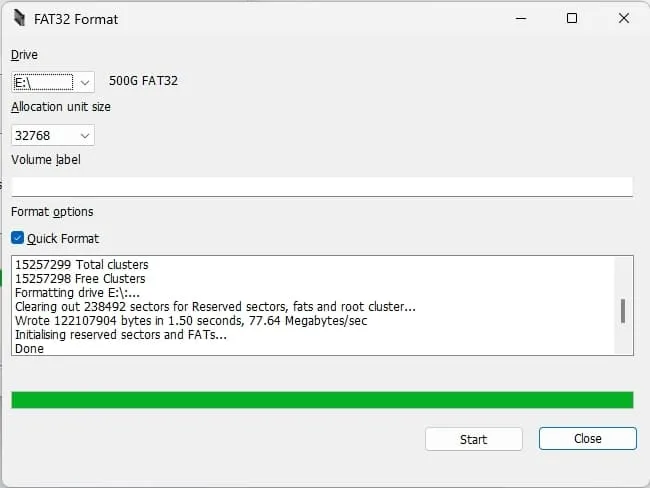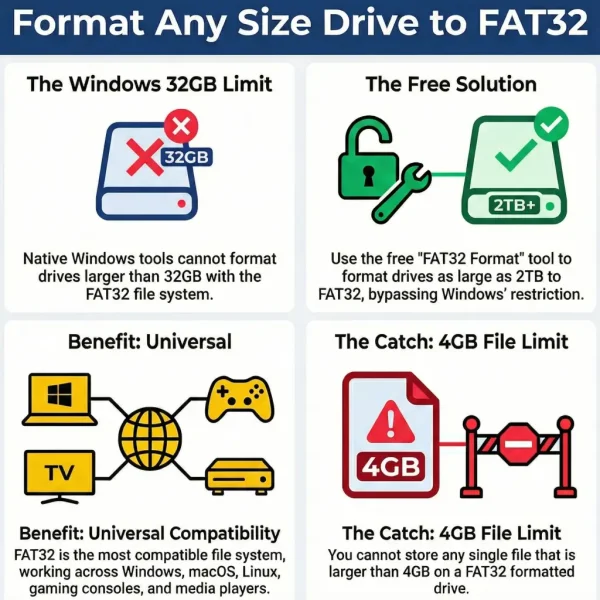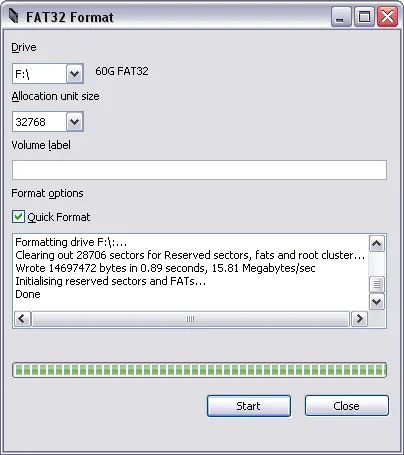Format FAT32 easily on USB drives larger than 32GB using the FAT32 Format Tool, a lightweight and portable utility designed to bypass Windows' built in size limitation. While Windows restricts FAT32 formatting to volumes of 32GB or less, FAT32Format removes this artificial restriction, allowing you to format large USB flash drives, SD cards, and external drives quickly and reliably.
Format FAT32 Larger Than 32GB (USB & SD Cards)

If you need to format FAT32 on a USB drive larger than 32GB, a third party formatter is required - and this tool does exactly that.
What Is FAT32 and Why It Still Matters
FAT32 (File Allocation Table 32) is a file system introduced by Microsoft in 1996 as an extension of FAT16. Despite its age, FAT32 remains widely used today due to its unmatched compatibility with operating systems, firmware, and consumer devices.
Many devices — including BIOS-based systems, UEFI firmware, game consoles, TVs, routers, and embedded hardware — still rely on FAT32 for removable media support.
Key FAT32 Characteristics
- Large Volume Support: Supports volumes up to ~2TB in practice and files up to 4GB minus 1 byte.
- Universal Compatibility: Works across Windows, macOS, Linux, BIOS/UEFI firmware, and countless consumer devices.
- Simple Structure: Uses a straightforward hierarchical directory tree that is easy for systems to read.
- Bootable File System: Required for many BIOS and UEFI boot scenarios.
- Performance Tradeoffs: Less efficient than NTFS or exFAT for large files or heavy workloads.
FAT32 vs exFAT vs NTFS
| File System | Max File Size | Max Volume | OS Compatibility | Bootable |
|---|---|---|---|---|
| FAT32 | 4GB | ~2TB | Universal | Yes |
| exFAT | 16EB | 128PB | Modern OS | No |
| NTFS | 16EB | 256TB | Windows-focused | Yes (UEFI) |
Why Windows Can’t Format FAT32 Over 32GB
A common misconception is that FAT32 cannot exceed 32GB. Though 32 is in the naming convention itself, this is incorrect.
The limitation comes from Windows' built in formatting tools, not from FAT32 itself. Microsoft intentionally restricts FAT32 formatting beyond 32GB to encourage the use of NTFS and exFAT. In reality, FAT32 can theoretically support volumes up to 16TB, with many third party tools such as the one reviewed here, safely supporting up to 2TB.
Using the right utility, you can format FAT32 on drives larger than 32GB without any issues.

Easily format large USB drives to FAT32
How to Format a USB Drive to FAT32 (Over 32GB)
To format a USB drive larger than 32GB to FAT32, you need a dedicated third-party formatter. One of the most reliable options is FAT32Format by Ridgecrop Consultants.
This portable utility allows you to:
- Force FAT32 formatting on USB drives, SD cards, and external drives
- Bypass Windows' 32GB FAT32 limitation
- Format volumes up to 2TB
- Create BIOS and UEFI bootable FAT32 partitions
Important: FAT32 cannot store individual files larger than 4GB. If large file support is required, consider NTFS, exFAT, or a dual partition layout.
FAT32 File Size and Volume Limitations
The primary limitation of FAT32 is its 4GB maximum file size. Attempting to copy a larger file will result in the error:
File is too large for the destination file system.
Workarounds include:
- Splitting files using a file splitter
- Using NTFS or exFAT for large files
- Creating a multi-partition drive (FAT32 + NTFS or exFAT)
FAT32 also has a directory entry limit (65,536 files per directory), and some modern applications perform poorly on FAT32 volumes.
About the FAT32 Format Tool (FAT32Format)
FAT32Format is especially useful when you need to format FAT32 on drives that Windows refuses to handle.
Developed by Ridgecrop Consultants Ltd., this open-source utility is widely regarded as the best free FAT32 formatter for large drives. It is portable, extremely small, and purpose-built for reliability.

- Extracted Size: 72 KB
- Developer: Tom Thornhill (Ridgecrop)
- License: Open Source
- Operating System: Windows XP – Windows 11
- Category: Drive Formatting Utilities
- Editor's Rating: ⭐⭐⭐⭐⭐
Download FAT32 Formatter
Download FAT32Format (GUI)
Download FAT32Format (Command Line)
The command-line version supports batch scripts and automation, making it useful for advanced users and system administrators.
How to Use FAT32Format
WARNING: Formatting erases all data. Back up important files first.
- Download and run
guiformat.exe - Select the target USB drive or SD card
- Leave allocation unit size at default (recommended)
- Optionally enter a volume label
- Click Start and confirm
- Wait for the process to complete
Pros and Cons of FAT32Format
Pros
- Formats any drive to FAT32 regardless of size
- Extremely fast and lightweight
- Portable - no installation required
- Ideal for bootable USB drives
- Compatible with legacy hardware and firmware
Cons
- No advanced disk management features
- 4GB per file size limitation
- Formatting permanently erases data
Related Tools You May Find Useful
Frequently Asked Questions about FAT32 Format
Can I format a USB drive larger than 32GB with FAT32?
Yes. FAT32Format allows you to format USB drives and SD cards larger than 32GB with FAT32 by bypassing Windows’ built-in limitation.
What is the maximum file size supported by FAT32?
FAT32 has a maximum file size limit of 4GB. Files larger than this cannot be stored on a FAT32 volume.
Why choose FAT32 instead of exFAT or NTFS?
FAT32 offers unmatched compatibility and BIOS boot support. For large files, NTFS or exFAT are better choices.
Can FAT32 be used on drives larger than 2TB?
FAT32 theoretically supports very large volumes, but most tools limit formatting to 2TB for stability and compatibility.
Why won't Windows let me format my large USB drive as FAT32?
Windows intentionally limits FAT32 formatting to 32GB. Third party tools like FAT32Format remove this restriction.
Final Thoughts on Format FAT32
FAT32Format is an excellent solution for overcoming Windows' artificial FAT32 limitations when formatting large USB drives, pen drives, SD cards, and other types of large external storage. It delivers broad compatibility, boot support, and portability in an extremely small package.
While FAT32 remains ideal for bootable media and legacy systems, be sure to remember its 4GB file size limitation. For modern workflows involving large files, NTFS or exFAT may be more appropriate. Always back up your data before formatting.
For BIOS booting, device compatibility, and legacy support, this free formatting tool remains one of the simplest and most reliable available.
